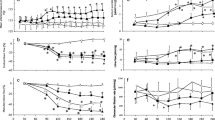Abstract
We have previously shown that the natriuretic response to DA-1 receptor agonist fenoldopam is markedly potentiated by angiotensin converting enzyme inhibitor captopril. Since inhibition of angiotensin converting enzyme can lead to decreased production of angiotensin-II and increased levels of kinins (e.g., bradykinin), it is likely that both of these mechanisms might be involved in this phenomenon. However, it is not known whether and to what degree the accumulation of kinins contributes to the overall potentiation of natriuretic response to fenoldopam seen during angiotensin converting enzyme inhibition. In the present study, we have examined the effect of angiotensin converting enzyme inhibitor enalaprilat and angiotensin-II receptor antagonist losartan as well as bradykinin-2 receptor antagonist HOE 140 on fenoldopam-induced natriuresis. Intravenous infusion of fenoldopam (1 μg/kg/min) for 30 min produced significant increases in urine output and urinary sodium excretion without causing any changes in glomerular filtration rate, renal blood flow and mean arterial blood pressure, a phenomenon suggestive of a direct tubular site of action. In animals treated with either the angiotensin converting enzyme inhibitor enalaprilat or angiotensin-II receptor antagonist losartan, the diuretic and natriuretic effects of fenoldopam were potentiated to a similar degree. Whereas no significant changes in glomerular filtration rate occurred when fenoldopam alone was given to control rats, in animals treated with either enalaprilat or losartan, fenoldopam produced a modest but significant increase in glomerular filtration rate. In a separate group of animals, the effects of bradykinin-2 receptor antagonist HOE 140 on potentiation of fenoldopam-induced natriuresis by enalaprilat was examined. It was found that the magnitude of changes in urine output, sodium excretion and glomerular filtration rate in animals receiving pretreatment with both enalaprilat and HOE 140 were similar to those with enalaprilat pretreatment alone. These findings suggest that the potentiation of natriuretic response to fenoldopam by enalaprilat is solely due to blockade of angiotensin-II production and kinins do not appear to contribute to this phenomenon.
Similar content being viewed by others
Abbreviations
- DA:
-
Dopamine
- JG:
-
Juxtaglomerular
- Ang II:
-
Angiotensin II
- ACE:
-
Angiotensin converting enzyme
References
Antonipillai I, Broers MI, Lang D (1989) Evidence that specific dopamine-1 receptor activation is involved in dopamine-induced renin release. Hypertension 13:463–468
Chen CJ, Apparsundaram S, Lokhandwala MF (1991) Intrarenally produced angiotensin II opposes the natriuretic action of the dopamine-1 receptor agonist fenoldopam in rats. J Pharmacol Exp Ther 256:486–491
Cogan MG (1990) Angiotensin II: A powerful controller of sodium transport in the early proximal tubule. Hypertension 15:451–458
Douglas J (1987) Angiotensin receptor subtypes of the kidney cortex. Am J Physiol 253:F1-F7
Felder RA, Felder CC, Eisner GM, Jose PA (1989) The dopamine receptor in adult and maturing kidney. Am J Physiol 257:F315-F327
Granger JP, Hall JE (1985) Acute and chronic actions of bradykinin on renal function and arterial pressure. Am J Physiol 248:F87-F92
Harris PJ, Navar LG (1985) Tubular transport responses to angiotensin. Am J Physiol 248:F1-F30
Heapy CG, Shaw JS, Farmer SC (1993) Differential sensitivity of antinociceptive assays to the bradykinin antagonist: in vitro studies. Br J Pharmacol 108:209–213
Hegde SS, Ricci A, Amenta F, Lokhandwala MF (1989) Evidence from functional and autoradiographic studies for the presence of tubular dopamine-1 receptors and their involvement in the renal effects of fenoldopam. J Pharmacol Exp Ther 251:1237–1245
Huo T, Healy DP (1989) Autoradiographic localization of dopamine DA-1 receptors in rat kidney with [3H]-SCH 23390. Am J Physiol 257:F414-F423
Ichikawa I, Harris RC (1991) Angiotensin actions in the kidney: renewed insight into the old hormone. Kidney Int 40:583–596
Johns EJ (1989) Role of angiotensin II and the sympathetic nervous system in the control of renal function. J Hyperten 7:695–701
Jose PA, Raymond JR, Bates MD, Aperia A, Felder RA, Carey RM (1992) The renal dopamine receptors. J Am Soc Nephrol 2:1265–1278
Kinoshita S, Ohlstein EH, Felder RA (1990) Dopamine-1 receptors in rat proximal convoluted tubule: regulation by intrarenal dopamine. Am J Physiol 258:F1068-F1074
Kurtz A, Bruna RD, Pratz J, Cavero I (1988) Rat juxtaglomerular cells are endowed with DA-1 dopamine receptors mediating renin release. J Cardiovasc Pharmacol 12:658–663
Lokhandwala MF, Amenta F (1991) Anatomical distribution and function of dopamine receptors in the kidney. FASEB J 5:3023–3030
Lokhandwala MF, Hegde SS (1990) Cardiovascular dopamine receptors: role of renal dopamine and dopamine receptors in sodium excretion. Pharmacol Toxicol 66:237–243
Montier F, Katchadourian P, Pratz J, Cavero I (1989) Increase in plasma renin activity evoked by fenoldopam in dogs is directly mediated by dopamine-1 receptor stimulation. J Cardiovasc Pharmacol 13:739–747
Sakamoto T, Chen CJ, Lokhandwala MF (1994) Contribution by bradykinin to the natriuretic response to angiotensin converting enzyme inhibitor ramiprilat in spontaneously hypertensive rats. Naunyn-Schmiedeberg's Arch Pharmacol 350:84–89
Vyas SJ, Apparsundaram S, Ricci A, Amenta F, Lokhandwala MF (1991) Biochemical, autoradiographic and pharmacological evidence for the involvement of tubular DA-1 receptors in the natriuretic response to dopexamine hydrochloride. Naunyn-Schmiedberg's Arch Pharmacol 343:21–30
Wang T, Chan YL (1990) Mechanism of angiotensin II action on proximal tubular transport. J PharmacoI Exp Ther 252:689–695
Wong PC, Price WA, Chiu AT, Duncia JV, Carini DJ, Wexler RR, Johnson AL, Timmermans PBMWM (1990) Nonpeptide angiotensin II receptor antagonists. IX. antihypertensive activity in rats of DuP 753, an orally active antihypertensive agent. J Pharmacol Exp Ther 252:726–732
Author information
Authors and Affiliations
Rights and permissions
About this article
Cite this article
Chen, C., Lokhandwala, M.F. Potentiation by enalaprilat of fenoldopam-evoked natriuresis is due to blockade of intrarenal production of angiotensin-II in rats. Naunyn-Schmiedeberg's Arch Pharmacol 352, 194–200 (1995). https://doi.org/10.1007/BF00176774
Received:
Accepted:
Issue Date:
DOI: https://doi.org/10.1007/BF00176774




